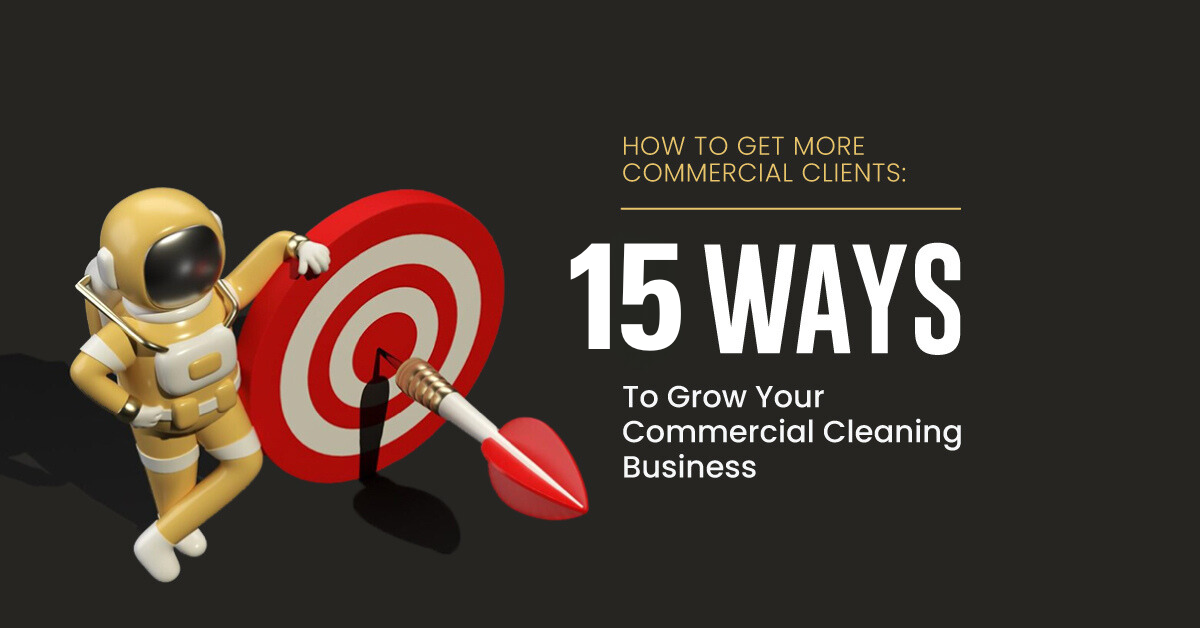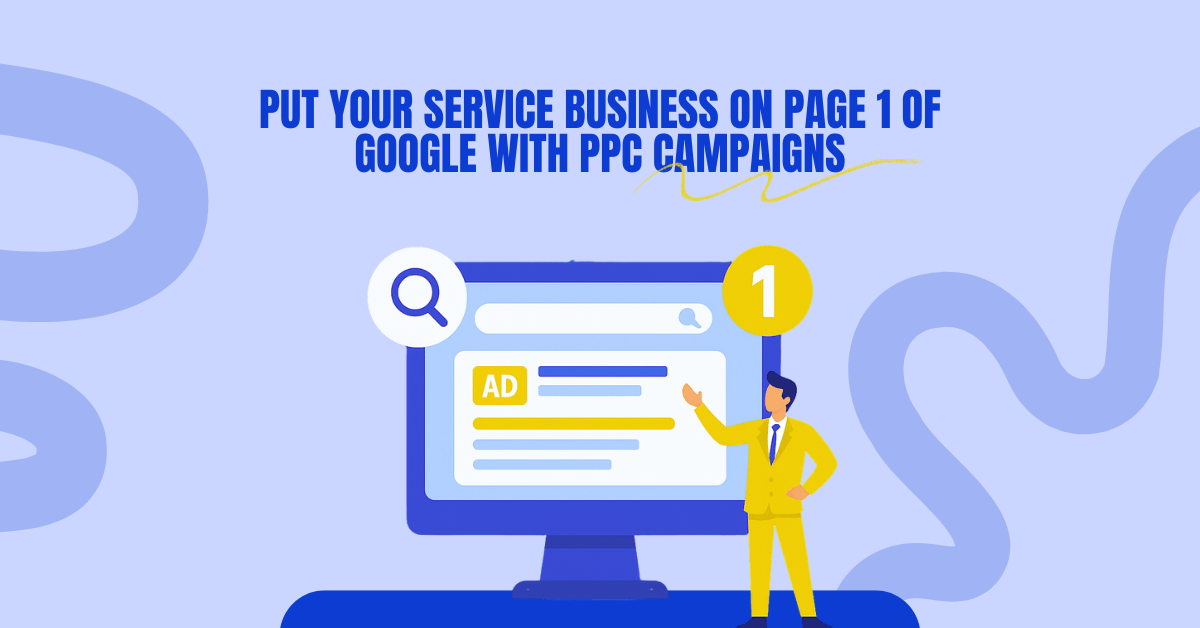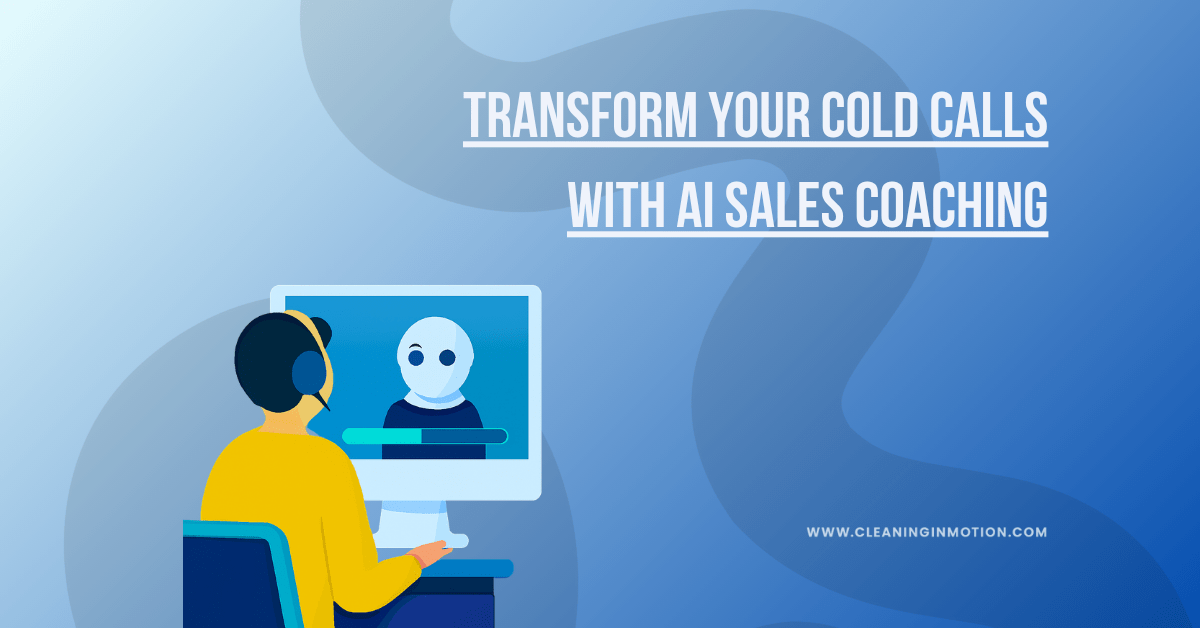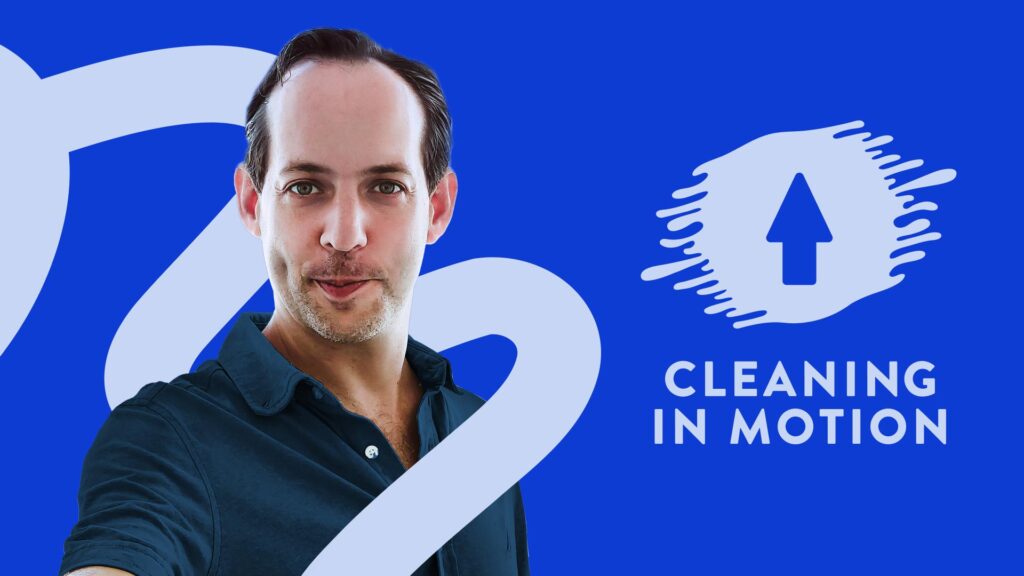Wondering how to get clients for a cleaning business? Who isn’t, right? There’s a lot you can do to help your business increase sales, leads, and conversions.
We’re very aware of how competitive the commercial cleaning market is, and devising a strategy to stay ahead of your competition is essential to get more clients and grow your company. At Cleaning in Motion we have devised 15 key steps that will help you get more customers. These are the result of strategies we have implemented to help our janitorial and cleaning clients gain more business, referrals and improve their and our reputations. Read on to learn more!
Best Way to Get Clients for Cleaning Business – 15 Key Steps
1. Define Your Target Market
Your ideal clients are facility managers responsible for maintaining cleanliness and hygiene in various commercial spaces. They prioritize efficiency, reliability, and cost-effectiveness when choosing their cleaning solutions.
- Demographics and Lifestyle: Facility managers are busy professionals, often working in fast-paced environments. They may be responsible for multiple properties or a large facility with a variety of needs. They value clear communication, responsiveness, and a hassle-free experience.
- Cleaning Needs: Their primary concerns include maintaining a clean, presentable, and healthy environment for employees, customers, or visitors. They need a cleaning service that is reliable, consistent, and trustworthy. They may require specialized cleaning services based on their industry (healthcare, education, hospitality) to meet regulatory standards or specific challenges.
2. Craft Your Unique Selling Proposition (USP)
What makes your cleaning business stand out from competitors? Highlight your strengths and tailor your message to resonate with facility managers. Here are some examples:
- Specialized Services: Offer services tailored to specific industries or facility types, demonstrating expertise and understanding of their unique needs. For example, you could offer specialized floor care for businesses with high-traffic areas or eco-friendly cleaning options for businesses focused on sustainability.
- Exceptional Customer Service: Providing 24/7 customer support, online booking options, and prompt issue resolution shows facility managers you value their time and are committed to providing a smooth experience.
- Competitive Pricing and Bundled Packages: Offer transparent pricing structures and attractive packages for recurring cleaning services, such as discounts for long-term contracts or bundled services that cater to specific facility needs. You can also offer a first-time discount to incentivize new customers to try your business.
- High-Quality Employees: Highlight your rigorous hiring process and how you ensure your employees are trustworthy, qualified, and trained to meet the highest standards of cleanliness.
3. Establish a Strong Brand Identity
A strong brand identity goes beyond just a name and logo; it encompasses the entire image and perception of your business. It’s about creating a consistent and professional experience for your clients at every touchpoint, from your website and marketing materials to your staff’s appearance and interactions.
A strong brand builds trust and recognition, making it easier for facility managers to choose your services over competitors. Let’s explore the key elements of building a strong brand identity for your commercial cleaning business:
- Professional Business Name and Logo: Choose a name that reflects professionalism, reliability, and your area of expertise. The logo should be visually appealing, memorable, and easily recognizable.
- Brand Consistency: Ensure your brand messaging, colors, and logo are consistent across your website, social media profiles, uniforms, vehicles, and printed materials. This creates a cohesive and professional image.
- Branded Vehicles: Consider wrapping your vehicles with your company logo and contact information. This turns your vehicles into “traveling billboards,” increasing brand visibility wherever you go. This strategy was recommended by a cleaning business owner who found it very effective.
4. Run an aggressive local campaign
Local marketing is the strategy of targeting audiences close to your business with messages reflecting the local market. The messages using this method rely on proximity. Local marketing engages with the communities to build a presence. The best ways to reach local communities are:
- Local SEO: Set up and optimize your Google My Business listing. If done right, this should be one of the primary sources of leads from your business location.
- Google ads: You can target the location you serve with paid advertising on Google which will appear on local searches because everyone uses it. Paid ads are a great way to make your business grow fast. It can become costly, but it’s worth every penny! You can get qualified leads for less than $150 per lead and you can select the industries and locations you want to target.
- Post Cards: The snail mail approach is more effective than you may think! Choose zip codes where you know there are lots of businesses, which you can find through Google (see?) and send them promotions and offers they can’t refuse; rinse and repeat, constantly.
5. Networking with the right people and networking groups
Business networking means establishing mutual relationships with other business people. Sounds simple, right?
Though the benefits are often intangible, the contacts you make and the top-of-mind status you can achieve from the communication you establish with other professionals in the commercial cleaning or janitorial industries are vital.
This networking is all about conversations and creating the right messages that click with them. This not only generates a higher conversion rate but can also gain amazing referrals for more work.
If you’re wondering where to look for these business owners and representatives, here are some ideas:
- Eventbrite is a service that allows users to browse, create, and promote local events. They charge a fee to event organizers in exchange for online ticketing services, unless the event is free.
- BNI – Business Network International is a franchised networking organization with over 275,000 members.
- Chamber of Commerce or board of trade
- MasterMind Groups are peer-to-peer mentoring groups used to help members solve their problems with input and advice from the other group members.
- LeTip is a business networking group for businesses of all shapes, sizes, and industries.
- LinkedIn is a business- and employment-oriented online network, but you probably know that.
- Facebook Groups related to your business and organizations.
- Women In Business Networking is a group of diverse women in business who encourage one another’s professional growth and success, made up of female entrepreneurs, business owners and key players in B2B services and the nonprofit environment.
- Local Business Groups, which you can find on Facebook, Twitter, LinkedIn and many other social networks or live gatherings.
For a peek into the best business networking groups to join, this article should be a big help.
6. Build a list of ideal clients
That sounds easy. But how do you make the list?
The first step is to find a database. Most databases are paid and it really makes sense because a good and verified list is no easy task. In our experience D7leadfinder is an excellent example of this, but Data.com offers clean and curated lists as well. LeadFerret is a free database, though the accuracy is not very consistent.
Most of these databases will let you search within certain industries, sizes, locations, and workforces. For commercial cleaning, you should be looking for doctor’s offices, dentist offices, clinics, hospitals, schools, office buildings, government buildings, or even churches.
Do your research before contacting them so you know what are their needs and how your cleaning company can help them. Then, as we have set it up in our No Leads Left behind webinar, it’s just a matter of sending the right message, at the right time, to the right person.
Remember: contact the people who make decisions about cleaning contracts. Everything else is pointless if you reach the wrong people.
Regardless of the database you choose, work it! Find the prospect’s social media, email, Linkedin profile, phone number. Anything you need to set up a robust pipeline that will enable a strong follow-up system.
7. Follow up with an attractive proposal, but make it personal
In order to make a sale, you might need to follow up with someone at least 5 times. Most salespeople give up after the first follow-up but it can take 5 to 10 follow-ups to get a customer to hire your services.
What you need to do here is propose a cleaning service plan that will be attractive to them. It also helps to make these as personal as possible. Sending gifts and handwritten letters with the proposal is a great way to take it to the next level. You’d be surprised to learn that a lot of commercial cleaning companies don’t get more clients because they use the pray and spray approach to outbound.
8. Offer actionable incentives to encourage them to act fast
Limited-time deals, coupons, and discounts are a way to get people to try your cleaning service. It makes them more likely because it will seem more exclusive. Plus, not having to spend as much money as a regular customer can make a new one feel special and important.
Offering discounts through social media or by visiting your website can help you attract new customers. Plus, it can also make your business more relevant online and score higher on Google. You can do this by creating messages that focus on your customer support, quality of service, or customer satisfaction.
9. Create a cold calling campaign to encourage interaction
Cold calling via phone call (as opposed to door-knocking) still remains an important skill for any commercial cleaning company looking to increase its leads. The importance of cold calling boils down to this: it’s a cost and time-efficient method of targeted, human-to-human lead generation.
The downside of cold calling is that many salesmen don’t like to do it. However, human interaction in today’s social distancing, and mainly texting society can sometimes be more valuable than you think.
Cold calling is an excellent tool for your salespeople to master their sales pitches. But it also can help you gain relevant information and make human connections with your customers, gauge the prospect’s personality, sense of humor, and so on, which you can’t always do over other media, and can go a long way toward starting a business relationship.
10. Use LinkedIn to find the best tools and the ideal people
Other than being a great social network, LinkedIn provides valuable tools for researching not only potential customers but also competitors. Understanding your prospects is half the battle, and through LinkedIn you can gain insight into what makes your prospects tick, what they’re involved in, and who they know.
LinkedIn will likely improve the quality of your connections with prospects in the cleaning market, which will eventually lead to better customers and bigger sales. This will help you determine what to offer and how to outdo the competition in terms of meeting the customer’s needs.
Perhaps one of the most important social selling points is that buyers want to do business with people they trust, and when you share connections (“friends” on LinkedIn), groups, or interests, with your prospects, it will likely identify you as someone who can be trusted.
If these connections can write and post recommendations sharing how you and your cleaning services are outstanding, that’s a great backup. These reputation builders offer you a priceless edge over the competition and can provide the nudge it takes to turn your prospects into customers.
11. Create cold email campaigns to generate new leads
Cold emails are one of the most effective outreach methods for generating new leads in the cleaning business. Thanks to the widespread availability of email automation and customer relationship management (CRM) tools, cold emailing is a less resource-intensive process than cold calling.
But cold emailing remains as one of the best one-to-one outreach tools, with the goal of building an ongoing relationship with the recipient when used in the right strategy, and as part of a larger plan, it can sometimes be the main source of leads and conversions.
12. Create a Google Business Profile
When looking for a cleaning business that will offer what a customer needs, 92.47% of people will use Google. The highest-rated search results will give enough information to pick the best option, like reviews, ratings, photos, and location information. Additionally, Google Maps is six times more popular than other navigation apps.
Given its popularity, it is critical to optimize your commercial cleaning business to appear in Google Maps search results. Google My Business (or GMB) lets you enhance your cleaning company profile to rank higher in search results. This means increased business visibility and higher revenue.
Google My Business is a free tool and your profile typically includes your business’ name, location, and hours of operation. You can invest in local search ads that will boost your business’s visibility in Google Maps search results by taking it to the top of search queries for the relevant keywords to your janitorial business, which is where SEO comes in.
13. Measure and Analyze Results
You’re putting in the effort to market your commercial cleaning business, but are you getting the results you want? Tracking the effectiveness of your marketing strategies is crucial for making informed decisions and maximizing your return on investment. After all, you want to spend your valuable time and resources on the approaches that resonate best with facility managers and bring in new clients.
Start by identifying key performance indicators (KPIs) that align with your marketing goals. Do you want more website traffic, leads generated, or social media engagement? Once you know what you’re aiming for, you can track the progress of each marketing effort.
For instance, if you’re running a direct mail campaign, use a unique coupon code on the flyer to track how many new clients sign up using that code. If you’re investing in social media advertising, monitor the click-through rates and conversions to see which ads are most effective.
Analyzing this data regularly helps you spot trends, identify successful strategies, and pinpoint areas for improvement. Maybe your social media posts with before-and-after cleaning photos generate the most engagement, while flyers targeting specific business parks lead to the most conversions. These insights empower you to allocate your marketing budget wisely and focus on the tactics that deliver the best results.
14. Stay Consistent with Marketing Efforts
Consistency is key to staying top-of-mind with facility managers. Think of it this way: you wouldn’t clean a building once and expect it to stay spotless forever, would you? Marketing is similar – it requires ongoing effort and attention to maintain momentum and build lasting relationships with potential clients.
Avoid the trap of reactive marketing, where you only ramp up your efforts when business slows down. This often leads to rushed campaigns that are less effective and may come across as desperate.
Instead, establish a consistent marketing schedule and stick to it, even when business is booming. This ensures that your brand remains visible and that you’re nurturing relationships with potential clients over time.
Regularly update your website and social media profiles with fresh content that provides value to facility managers. Share cleaning tips, industry news, or case studies highlighting your success stories.
Engage with your audience by responding to comments and messages promptly, showing that you’re invested in building a connection. Remember, consistency builds trust and credibility, positioning your business as a reliable and professional cleaning partner for facility managers.
15. Provide Continued Value
Facility managers are very busy with their daily work, which means that standing out requires offering more than just a sales pitch. To truly capture the attention of facility managers and build lasting relationships, focus on providing consistent value through your marketing efforts.
Position yourself as a trusted resource by sharing valuable content and insights related to commercial cleaning. Create informative blog posts addressing common challenges faced by facility managers, such as maintaining hygiene standards, optimizing cleaning schedules, or choosing eco-friendly cleaning products.
Social media is a powerful platform for sharing quick tips and engaging content. Post before-and-after cleaning photos, time-lapse videos, or fun facts about cleaning to capture attention and spark conversations.
Email marketing is a great way to stay connected with potential clients and share exclusive content. Offer a free downloadable guide on “10 Tips for a Healthier Workplace” or send out a monthly newsletter with industry updates and special promotions. By providing consistent value through your marketing, you’ll attract facility managers who are genuinely interested in your expertise and are more likely to choose your services when the need arises.
So there you have it! 15 tried and tested methods at Cleaning in Motion that have increased and improved our commercial cleaning business clients.
Either of them alone can do wonders for your cleaning business, but when used together and with a sound strategy, they can be the most powerful set of tools that will get you more cleaning clients, grow your business, and boost your revenue.
Check out our commercial cleaning success stories if you’re still unconvinced.
If you’d like to schedule a talk with us, just click here.
FAQs About How to Get Clients for a Commercial Cleaning Business
How much should I spend on marketing my cleaning business?
There is no one-size-fits-all answer to this question, as the ideal marketing budget varies depending on factors like the size of your business, your target market, and your marketing goals. However, a good rule of thumb is to allocate between 5% to 10% of your revenue to marketing efforts. It is important to note that this information is not from the sources you provided and you may want to independently verify it.
What are some effective ways to get my first few clients?
Networking: Attend industry events, join local business associations, and reach out to property managers in your area.
Referrals: Leverage your personal and professional network by asking friends, family, and former colleagues to spread the word about your business.
Online Presence: Create a professional website and optimize your Google Business Profile to appear in local search results.
Direct Mail: Target specific neighborhoods or businesses with flyers, postcards, or door hangers.
How can I differentiate myself from established cleaning companies?
Specialize: Focus on a niche market, such as green cleaning or healthcare facilities, to stand out from the competition.
Offer Value-Added Services: Go beyond basic cleaning by providing services like floor waxing, window cleaning, or carpet shampooing.
Exceptional Customer Service: Prioritize responsiveness, clear communication, and going the extra mile to exceed client expectations.
Competitive Pricing: Research your competitors’ rates and offer competitive prices while ensuring profitability.
How do I handle negative online reviews?
Respond Professionally: Address negative reviews promptly and politely, acknowledging the customer’s concerns and offering a solution if possible.
Don’t Engage in Arguments: Avoid getting defensive or engaging in public arguments with reviewers, as this can further damage your reputation.
Encourage Positive Reviews: Proactively request reviews from satisfied clients to build a positive online presence and counterbalance negative reviews.





